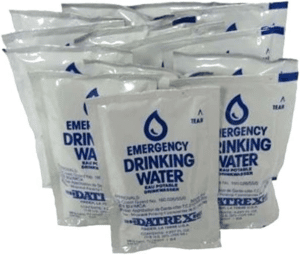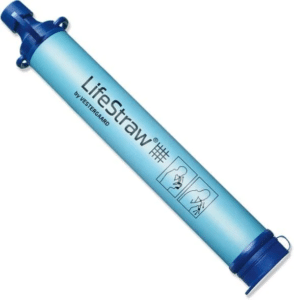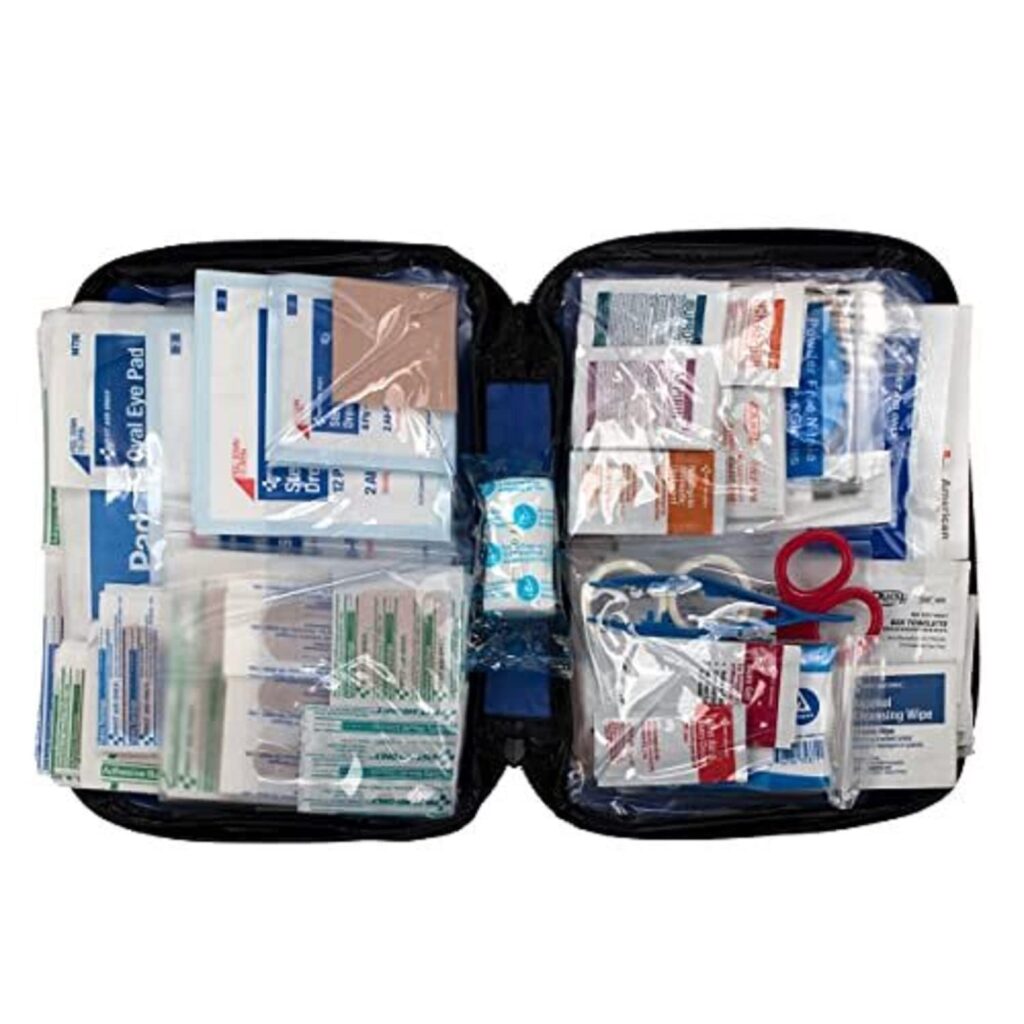Building Your Go Bag Has Never Been So Easy
This free, step-by-step guide will walk you through the process of making a go bag.
Let’s be honest… creating a go bag can be overwhelming. Because it can be a daunting task, many people put it off. The truth is whether you start today or tomorrow, it isn’t going to be any easier and the time will never be perfect unless you put in the effort.
With this free, step-by-step guide, it is our mission to make the experience easier and, who knows, you might actually have fun! With just a little preparation, you can build a go bag that will keep you and your family safe in the event of a disaster.
In this guide, we will cover the basics needed to create a personalized go bag. If you just rather buy a premade go bag and skip ahead to the end, no problem! No judgment here! Check out our Buy a Go Bag Guide!!
Ok, let’s get started. Please note that this guide does contain affiliate links to products we stand behind. If you use these links to buy something, we may earn a commission that will help keep this free website running.
The Main Categories
Creating your go bag can be broken down into 8 categories. These are:
- Food and Water
- Shelter
- First Aid
- Communication
- Survival Tools & Accessories
- Essential Documents
- Bag
- Other Useful Items
In this guide, we will spend time on each of these categories by explaining why they are important and by providing product recommendations. Additionally, we will take into consideration if you are making a go bag for one person, two people, or a family of four.
Step 1 – Food and Water
Food and water are the most important things to have in your go bag. According to the survival rule of 3, we cannot survive three days without water and three weeks with food. While not an exact science, it does provide a general guideline for how long a person can go without these essential elements in a survival situation.

When it comes to choosing food for your go bag, the right balance of nutrition, portability, price, and shelf-life has to be considered.
- Nutrition: While in an emergency situation foods that having high calorie count will provide enough energy and keep one full for longer.
- Portability: Go bags have a contained size and there needs to be room for other essential items. So one’s choice of food needs to be compact.
- Price: Creating a go bag for a family can get expensive. Fortunately, there are a lot of options on the market that are cost-effective.
- Shelf-life: While we recommend checking your go bag yearly, food such as energy bars have a long shelf-life. This will allow you to keep the food edible for longer.
For more of a deeper discussion on emergency food for your go bag, please read our Emergency Food Guide.
So what kind of food should you get? Non-perishable food items, such as energy bars, jerky, and nuts, are great options. If you are looking for something more survivalist, we recommend the Datrax 3600 Emergency Food Bar – 3 Day/72 Hour Bar. Each bar has 200 calories and there is enough in the pack for a family of four to ration over the course of three days.
Two additional more tasty options are the Vanilla Poundcake Bars and the Chocolate Emergency Bars. There is enough in the package for one person. So we suggest to multiply for additional members of the family.
—
With water, there are a variety of options to choose from. Options include:
- Water Pouches: These are lightweight, purified, and can easily fit in a bag.
- Water Purification Straw: These straws are designed to filter water from any source while drinking. While this might seem nerve-wracking, the reviews are overwhelmingly positive.
- Water Purification Tablets: These tablets are specially formulated to purify water to be drinkable in mere minutes.

Because these water options are so affordable, compact, and practical we recommend that you buy each one for your go bag. You won’t regret it! For a deeper discussion about water options and purification, please read our Emergency Water Guide.
—
By this point, you should have the food and water you need in your shopping cart. Make sure to consider the amount you need for you and your family. In some cases, you might have to buy more than one of an item. Once you have completed this, you are ready for the next step.
Step 2 – Shelter
So far so good, right? In this step, we are going to focus on another important part of any go bag. While according to the survival rule of 3, we cannot survive three days without water and three days with food, we also cannot survive 3 hours without shelter in extreme conditions. Having shelter is definitely a needed item for your go bag.

Shelter can come in different forms. Some of the most coming shelter items are:
- Tents: While we tend to think of tents as big and bulky, emergency shelter tents are lightweight and durable. The most common tents can fit two people. So if you have a family of four or more, consider buying multiple tents for your go bag.
- Blankets: We’re not talking about the comfortable blankets that are on your bed. For emergency situations, you will need something lightweight and functional. Emergency thermal blankets utilize a special material that protects from weather conditions by keeping one dry and retains up to 90% of a person’s body heat. Most of these come in packs of four, which makes it ideal for a family.
- Ponchos: Protecting from precipitation will keep one dry and prevent conditions such as hypothermia and shock.
- Bivy Sacks: Many people might now have heard of a bivy sack. Think of it as a weather resistant, lightweight sleeping bag. Like the tent and thermal blankets, these will keep you warm and take up little space in your go bag.
- Tarp: This is a fine alternative to tents, blankets, and bivy sacks as they are versatile and can be used in a variety of settings and ways.
Which one should you get? Ultimately, it comes down to preference. From our research, we have found that having a tent, thermal blankets, and ponchos to be the right level of coverage, portability, and usage. We recommend that you think about your family size and plan accordingly. Do not leave anyone out in the cold!
For a deeper discussion on emergency shelter, please check out our Emergency Shelter Guide.
Step 3 – First Aid
While it is our hope that no one gets hurt, accidents do happen. Because of that, first aid is important – not just for ourselves, but for others as well.
First aid kits are also an essential part of a go bag. A basic first aid kit should include:
- Bandages
- Aspirin
- Cold Compress
- Gloves
- Hydrocortisone Ointment
- Roller Bandages
- Tweezers
- Gauze Pads
- Antiseptic Wipes
- Cloth Tape
A small compact first aid manual is also a good idea in case there is a need to reference it for treatment instructions.
We recommend that you buy a first aid kit as opposed to creating one. There are so many viable first aid kits on the market that include all of the essential items and more in a compact package and good price.
Two good examples of first aid kits worth your consideration:
To learn more about first aid kits, take a look at our First Aid Kit Guide.
Step 4 – Communication
Most of us have cell phones and in most situations, we will still be able to communicate and search the internet freely. However, as seen in other disasters, cellular service is not always ensured. So we need to consider what we will do if we aren’t able to use our smart devices.
One prime way to make sure we stay alert is to have an emergency radio. Emergency radios are just what the name implies – radios designed to be used in the event of an emergency. When the unexpected happens, staying informed with pertinent updates helps us stay prepared and ready if and when the need for decisive action is needed.
There are a wide range of emergency radios available on the market. It is important that you looking for ones that are specifically identified as emergency radios and not just AM/FM radio as these serve different purposes and have different features.
Features to look for in your emergency radio include:
- NOAA
- Charging either through DC, USB, solar panels, or hand crank
- Good reviews about reception
- Durability, size, and weight
- Waterproof
- Flashlight (bonus feature)
- Charger (bonus feature)
- Clock
We recommend the Midland Emergency Crank Weather AM/FM Radio. However, you cannot go wrong with many of the options that are available on the market.
More information about emergency radios can be found on our Emergency Radio Guide.
At this point, you are halfway done with creating your go bag and as promised, it wasn’t too bad. So what now? It’s time to talk about survival.
Step 5 – Survival Tools & Accessories
Survival tools are anything that one needs in order to survive in the case of an emergency or disaster. Being that these events can be unpredictable, having the right set of tools to cover multiple situations is important.
While we cannot capture every tool one can have in their go bag, here is a list of survival tools and accessories we recommend packing:
- Pocket Knife Multitool
- Emergency Glow Light Sticks
- Masks
- Whistle
- Flashlight
- Tape
- Rope
- Portable Lighting
- Battery Pack
Seems like a lot, but each of these things take up little room in bag. However, if you want to make things a little easier, might we recommend a survival tool kit. These things are awesome because they are so versatile, contain so many items, and it’s compact enough to fit in your go bag. The one we recommend has some of the things we already discussed such as a first aid kit, tent, and poncho, but also has things such as a shovel, knife, compass, and flashlight. Go see for yourself.
Step 6 – Essential Documents
In the previous sections, we spoke about things needed for survival – food, water, and shelter. We spent time talking about communication and survival tools. Now, let’s take a moment to talk about essential documents to have in your go bag.
When told to flee, we only have a few moments to grab our bags and go. Time spent trying to gather documents could threaten our safety. So, it is best to take time now so we have that peace of mind later.
Essential documents include copies of:
- Your driver’s license, or other photo ID
- Social security cards
- Passports
- Medical ID cards, insurance information, or medical duration power of attorney (DPA) cards
- List of important phone numbers
- Copies of credit cards
- Copies of bank statements
For a more exhaustive list of important documents to have, check out FEMA’s list of critical documents to have in the case of an emergency. This checklist will allow you to mark off the items that you have and help you gather the documents that you haven’t packed.
Storing these documents is something that also needs to be considered. Having your files in a waterproof folder will protect them from the elements and keep them safe in your bag. A flash drive is also a good choice for storing files. We highly recommend the Corsair Flash Survivor Stealth 64 GB USB 3.0 Flash Drive as its rugged design along with it being waterproof up to 200 meters, vibration-resistant, and shock resistant make it a solid addition to your go bag.
Step 7 – Bag
You can’t have a go bag with having… a bag. In this step, we are finally going to take all of the items you have purchased that are currently sitting on your living room floor or in your shopping cart and finally get a place to put them.
There are two main options when it comes to a bag. The options are:
- Backpacks – the preferred choice as it is easy to carry, can hold a lot of items, small enough to fit in a closet, and makes moving easier.
- Dufflebags – carries more than a traditional backpack, but not as comfortable and efficient as a backpack.
- Rolling Bags – good for older couples or those with back problems. The one we recommend in this category is also a backpack.
There are so many bags to choose from a we have tried several. We recommend ones designed for hiking as these come in large capacity and are rugged enough to withstand wear and tear. Here are two that we recommend. The first is one that we personally use for one of our go bags.
Step 8 – Other Useful Items
Now that we have covered the major items, let’s mention a few other items that would be worthwhile to have in your go bag. These include:
- List of emergency contacts and meeting places and a local map
- Credit cards and cash
- Extra set of house keys and car keys
- Paper, pens, and activities for children
- Extra set of clothes
Congratulations! You Did It!
If you made it to this point, you now have a complete go bag. These items will no doubt help you in the event of a disaster or emergency and will give you piece of mind.
In this guide, we covered a wide range of go bag essentials. If you haven’t already, prepare now. Spending a moment now is a moment saved later.
What should you do now? Tell others about the Go Bag Guide so that they too can prepare a go bag. Look over our other guides including the ones on disaster preparedness.
We here at Go Bag Guide thank you for reading this guide and hope that you found this information helpful.
Ready to make your emergency go bag?
Stay one step ahead of a disaster later by taking steps to prepare now.

















